Perennials are the perfect choice for stunning garden beds. Plus, there are countless varieties available! So, how do you choose which perennials to plant? We’ve put together a list of hardy, colorful, and easy-to-grow perennials for all gardeners. Keep reading for the 14 best perennial plants that come back every year! From hosta and lavender to peonies and salvia, these perennials are gardener favorites.
Before we dive into our list, let’s first look at what perennial plants are and the most common types you can grow. Knowing the type of perennial will help you better understand each plant’s growth habits.
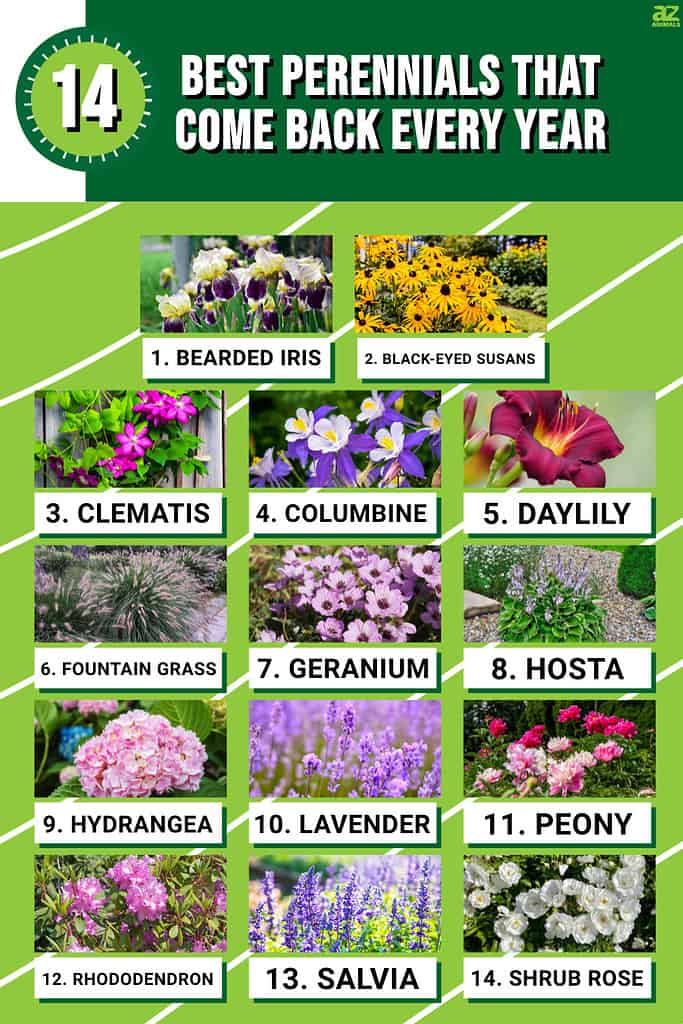
What Are Perennial Plants?
Perennials are plants that live over two years and overwinter well in a garden or container. Unlike annuals, perennials don’t need replanting each season.
Perennial plants come in many different types, including the following:
- Herbaceous — These plants are hardy and low maintenance with long-lasting blooms. For example, many salvia varieties are herbaceous perennials.
- Evergreen — These plants provide year-round beauty in your landscape, even during the colder months. For example, rhododendrons are evergreen perennial shrubs.
- Woody — These plants are larger and can be a focal point in your garden. Many shrubs, trees, and vines are woody perennial plants, including roses.
- Shrubs — Shrub-type perennials, like rhododendron and hydrangea, come back year after year with colorful foliage or showy flowers.
- Grasses — Ornamental grasses, like fountain grass, add texture, height, and flowing movement to your garden.
- Bulbs/Tubers — Bulb-type perennials, such as peonies, come back each year with fragrant blooms in various colors.
- Vines — Climbing vines, including clematis, produce beautiful flowers or foliage that add height and privacy to your garden.
Perennials will bring beauty to your landscape no matter which plant type you choose. With the proper care and maintenance, these plants will last for years. Now that you know what perennial plants are, let’s look at some of the best perennials that come back every year.
1. Bearded Iris
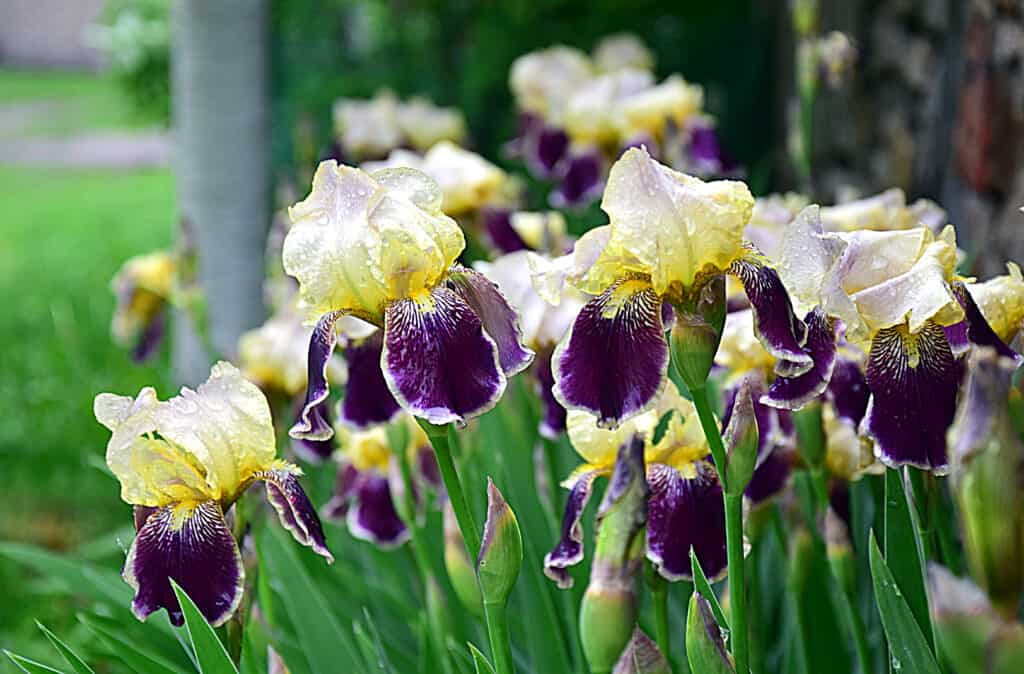
The bearded iris’s blooms grow up to 6 inches across in late spring and early summer.
©Krzysztof Bubel/Shutterstock.com
Perennial type: Bulb
Hardiness zones: 3-10
Sunlight needs: Full sun
Bearded iris flowers are among the most popular perennial plants that come back yearly. They have showy, unique flowers ranging from white to yellow, blue, violet, and more.
The bearded iris has long, sword-like leaves that grow from the base of the plant. Their large blooms have upright petals called standards, and two sets of downward-facing petals called falls. The name bearded iris comes from the fuzzy hairs that appear on the falls of some varieties.
The bearded iris’s blooms grow up to 6 inches across in late spring and early summer. In addition, the plants reach heights of 1-4 feet tall, depending on the variety.
While it’s very easy to care for once established, the bearded iris grows best in direct sunlight. Therefore, bearded irises will reward you with plenty of blooms for many years when planted in sunny beds.
2. Black-Eyed Susans
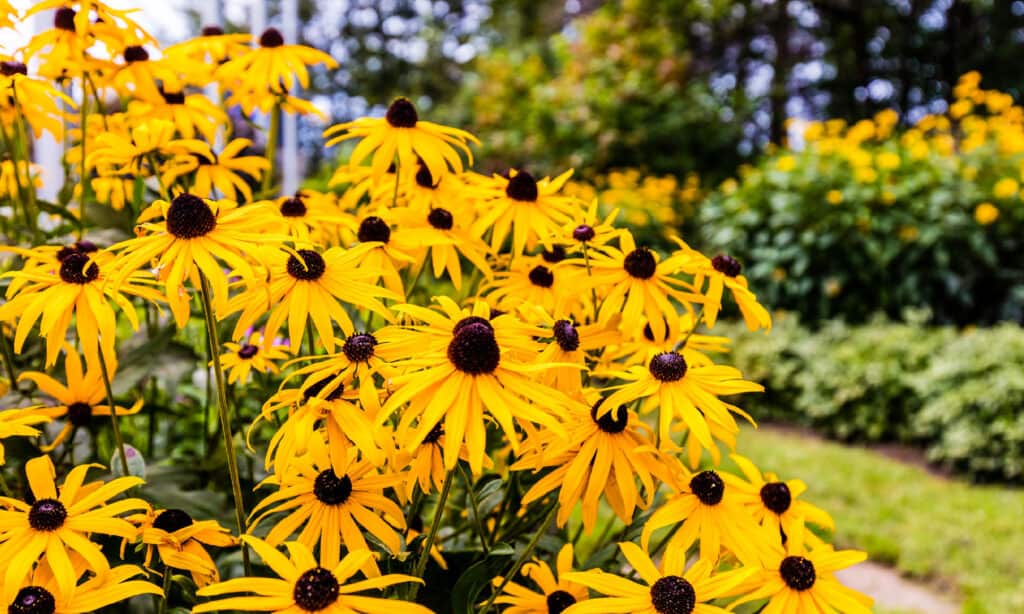
Black-eyed Susans or coneflowers
are popular perennial plants for summer gardens.
©iStock.com/Dopeyden
Perennial type: Herbaceous
Hardiness zones: 3-9
Sunlight needs: Full sun to part shade
Black-eyed Susans or coneflowers are popular perennial plants for summer gardens. These hardy and easy-to-grow flowers feature bold, daisy-like blooms with yellow petals surrounding a dark center.
These perennial plants that come back every year have bright green foliage and grow up to 3 feet high. In addition, they have a long blooming period from summer to late fall and attract butterflies and other pollinators.
Black-eyed Susans prefer full sun to part shade. Moreover, they are drought-tolerant and easy to grow, making them an ideal addition to any garden!
3. Clematis
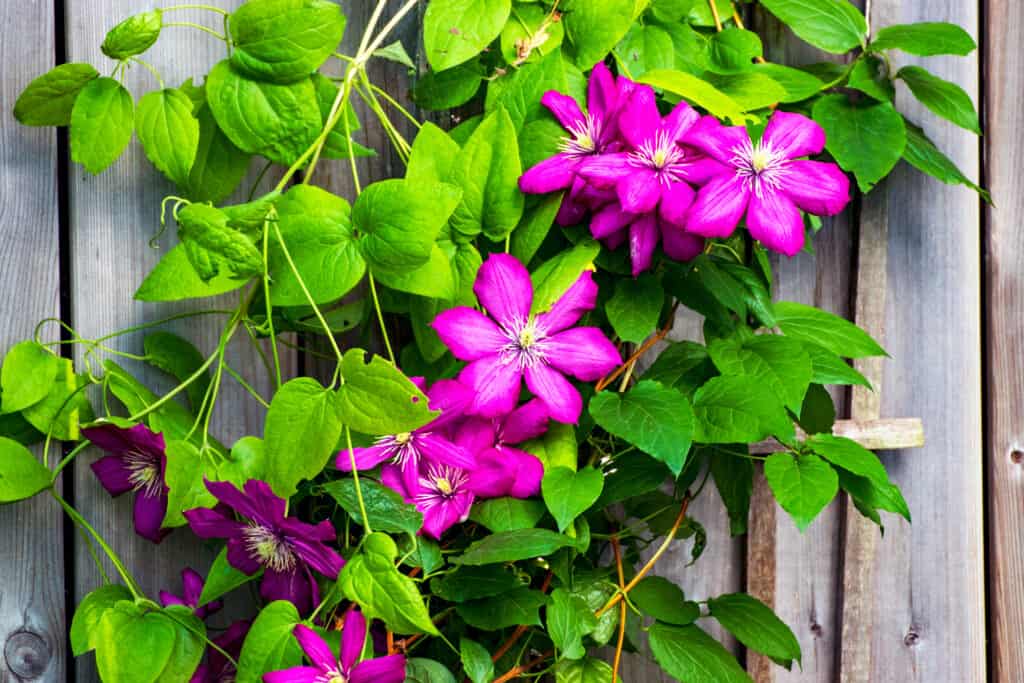
Clematis
flowers are hardy perennials
from the buttercup family.
©iStock.com/Karen Hogan
Perennial type: Herbaceous vine
Hardiness zones: 4-8
Sunlight needs: Full sun
You could get dizzy learning about all the clematis varieties available for home gardening! So we’ll focus on just one type: the herbaceous perennial vines. The herbaceous group of clematis vines includes fast-growing and low-maintenance perennial plants. This clematis produces showy clusters of small bell-shaped blooms that come in blue, pink, and white, depending on the cultivar.
The foliage of this perennial plant is medium green and forms bushy clumps. The plant grows up to 2 feet or more but might climb even higher. Herbaceous clematis vines love to cling (via their stems) to structures such as trellises, arbors, and fences.
Clematis prefers full sun for best blooms. Deadheading the plant’s spent blooms promotes more flowering. Although it takes a few years to get established, once it does, you’ll be rewarded with beautiful blooms all season long.
Do you know what kind of clematis you’re planting? If not, here’s a quick list of the main clematis types:
Large-flowered varieties, including the following groups:
- Early blooming group (spring to early-summer blooms)
- Late blooming group (mid-summer to fall blooms).
Small-flowered varieties, including the following groups:
- Atragene Group: cold-hardy and easy to grow
- Evergreen Group: year-round blooms, including winter months
- Herbaceous Group: perennial clematis that dies to the ground every autumn
- Montana Group: fragrant climbers with loads of blooms
- Orientalis Group: bright yellow, star-shaped blooms
- Viticella Group: strong climbers that grow well in large pots.
4. Columbine
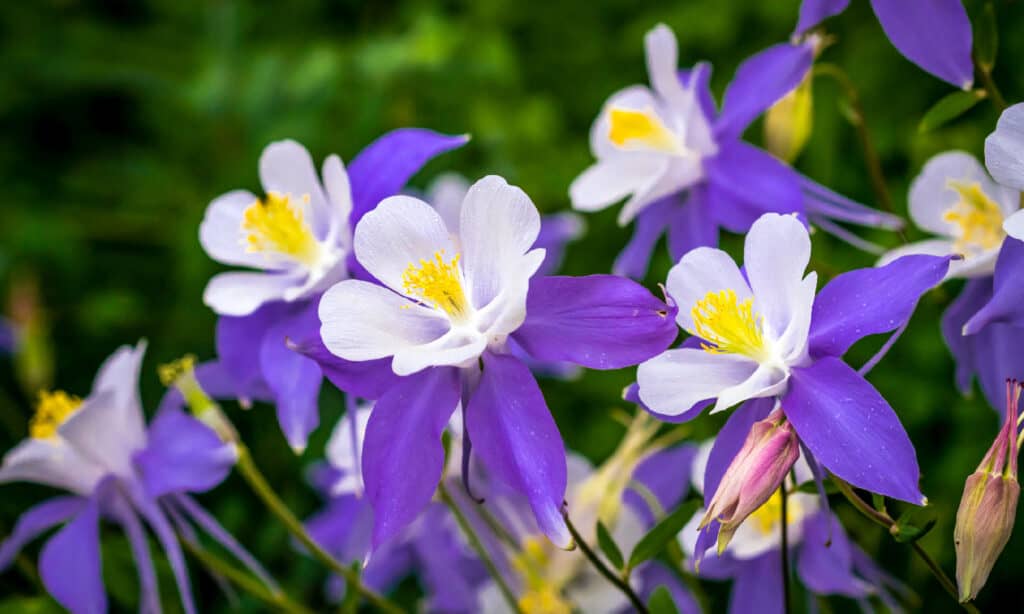
Columbines are easy-to-grow perennials that have thin stems and beautiful bell-shaped blooms.
©iStock.com/tvirbickis
Perennial type: Herbaceous
Hardiness zones: 3-8
Sunlight needs: Full sun to partial sun
Columbines are easy-to-grow perennial plants that come back every year. The common columbine (Aquilegia vulgaris) is a bushy plant with thin stems and beautiful bell-shaped blooms. Its delicate drooping flowers have five petals and come in white, pink, yellow, and blue. However, the common columbine isn’t the only variety of this plant available! Some columbines, like the false columbine, have petals in soft colors. Other columbine plants have bright and vibrant blooms.
The foliage of the common columbine plant is deeply lobed and grows to heights of 1-3 feet tall. Unfortunately, this columbine has a short growing season from late spring through early summer. Yet these plants produce blooms so lovely that they’re worth the brief show!
5. Daylily
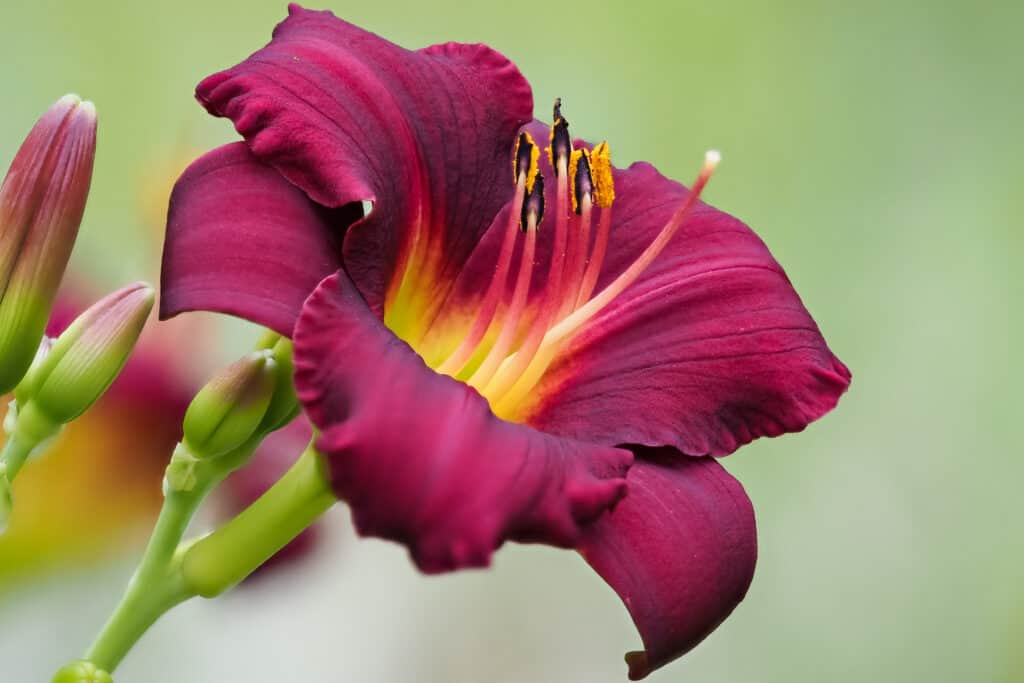
Daylilies grow best in full to partially sunny areas and need well-drained soil.
©Serge Goujon/Shutterstock.com
Perennial type: Herbaceous
Hardiness zones: 3-9
Sunlight needs: Full sun to part shade
The dazzling daylily is one of the hardiest and showiest perennial plants that come back every year. This stunning and low-maintenance plant has large blooms perfect for bouquets or flower arrangements.
The blooms of a daylily come in many colors, from yellow to red. The flower’s petals form a trumpet shape with a ruffled edge, surrounding a bright golden center. Each bloom only lasts for one day, but the plant produces multiple flowers throughout the growing season. However, your best bet for continuous garden blooms is to plant some reblooming daylilies. So be on the lookout for reblooming daylilies at your local garden center or wherever you buy your garden plants.
Daylilies grow best in full to partially sunny areas and need well-drained soil. Fortunately, these perennial plants are drought-tolerant with average water needs. In addition, daylilies are hardy and low maintenance but benefit from dividing the plants every few years.
6. Fountain Grass
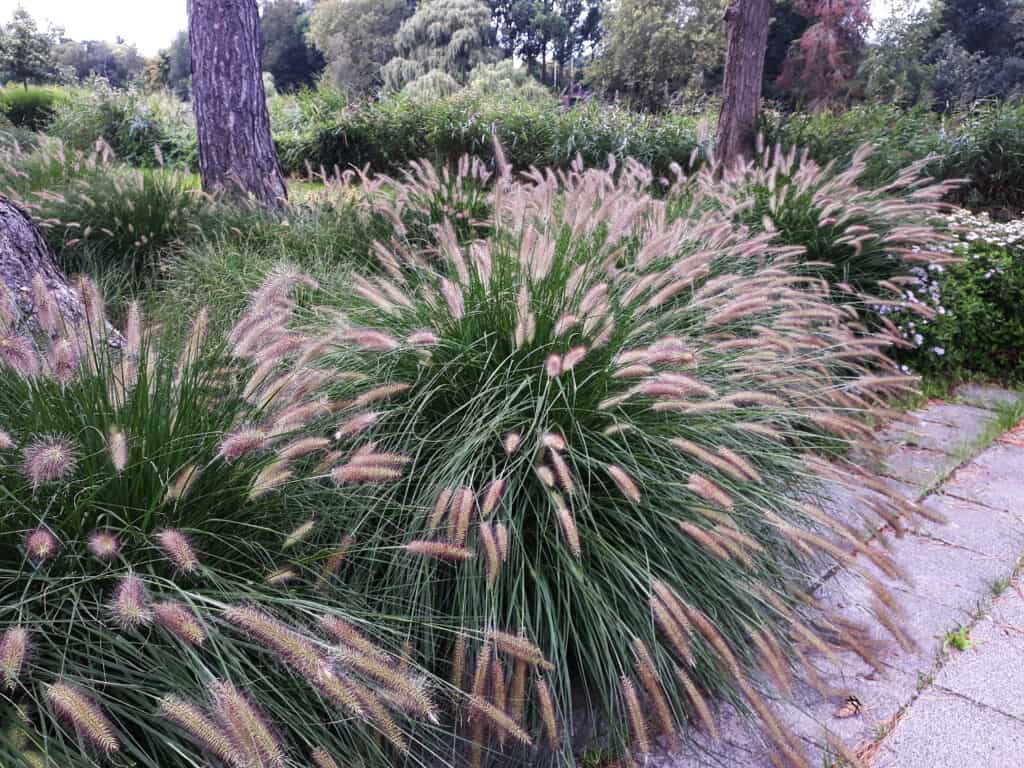
Fountain grass is a low-maintenance plant that only needs to be trimmed back once a year in spring.
©Gabriela Beres/Shutterstock.com
Perennial type: Grass
Hardiness zones: 5-10
Sunlight needs: Full sun to part shade
Fountain grass is a perennial ornamental grass that looks beautiful in the garden from late spring through fall. The foliage of this plant is thin and delicate, with fine blades that sway gracefully in the wind. It produces fluffy flower heads that look like soft white clouds during summer.
Fountain grass grows in clumps 1-4 feet tall. Its stems are green in spring and summer, then turn tan to brown in the fall. Additionally, fountain grass is a low-maintenance plant that only needs to be trimmed back once a year in spring.
This tall, flowy perennial plant adds texture and movement to your garden or landscape. It prefers full sun, though it can tolerate some shade. Once established, fountain grass is drought-tolerant and can thrive without much water.
7. Geranium
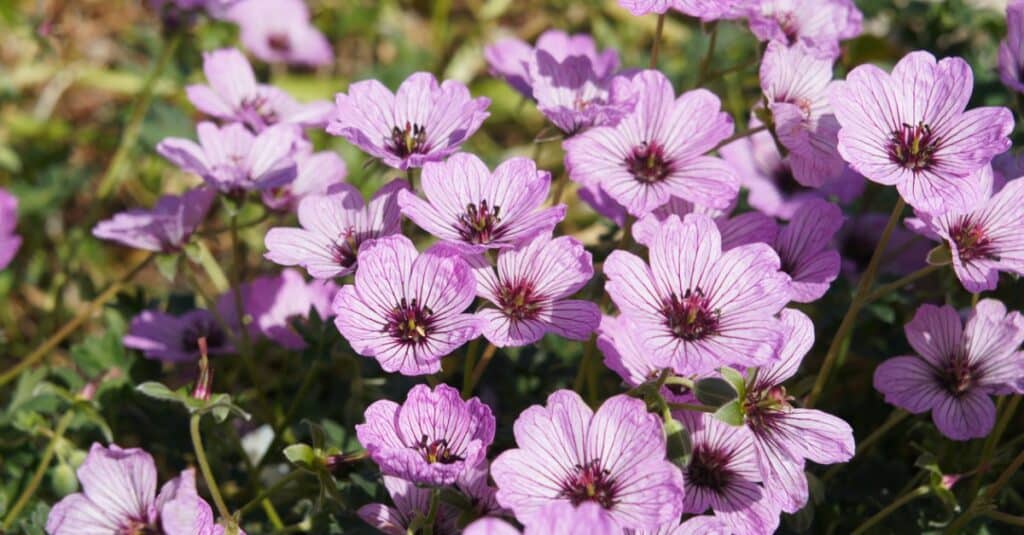
The blooms of a hardy geranium come in many different colors, including pink, red, white, and blue.
©iStock.com/skymoon13
Perennial type: Herbaceous
Hardiness zones: 4-9
Sunlight needs: Full sun to part shade
Geraniums or cranesbills are hardy perennial plants that are easy to grow for gardeners of all experience levels. Their flowers have bold, bright colors and come in many shapes and sizes. These plants are pest-resistant, cold-tolerant, and bloom from late spring to fall. Plus, their fragrant blossoms attract bees and butterflies for added enjoyment in your outdoor space!
The blooms of a hardy geranium come in many different colors, including pink, red, white, and blue. In addition, the blooms are cup-shaped with pretty ruffled edges. The foliage of a cranesbill geranium is deep green and lobed, with leaves that grow to be about 3 inches long. This popular garden plant grows up to 2 feet tall with a 3-foot spread.
Plant your cranesbill geraniums in a sunny spot, in well-drained soil, and water once a week. Deadhead the spent blooms to keep your geraniums fresh and blooming throughout the summer months. Also, dividing your geraniums every three or so years will
8. Hosta
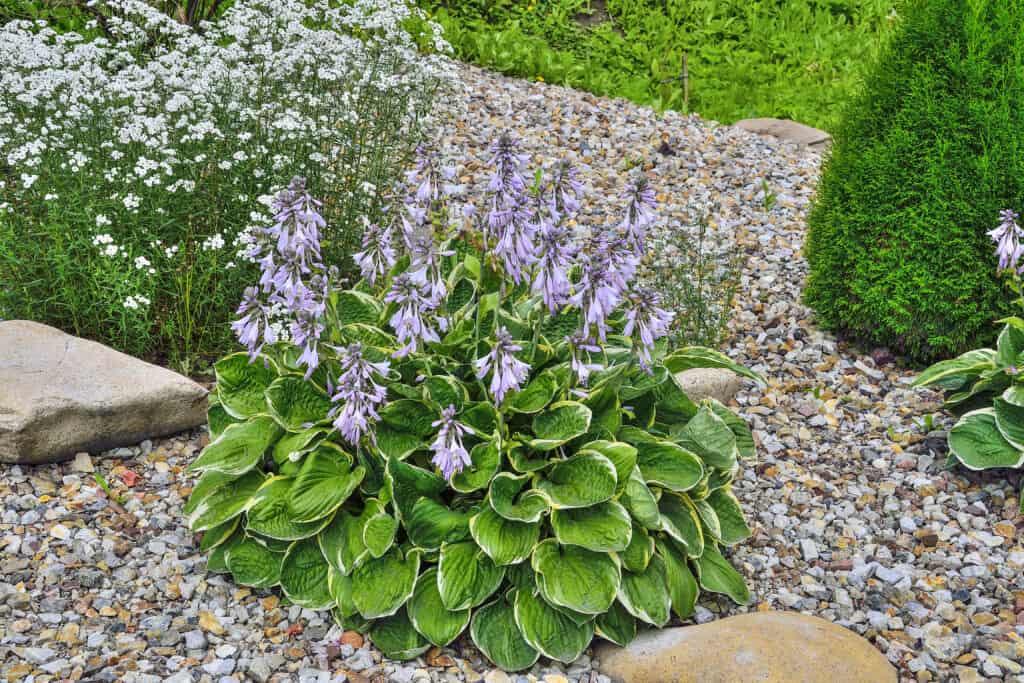
Hostas are unpretentious, shade-tolerant for landscaping design in
parks
or gardens.
©iStock.com/Rvo233
Perennial type: Herbaceous
Hardiness zones: 3-9
Sunlight needs: Part shade to full shade
Hostas, otherwise known as plantain lilies, are clump-forming perennials. The foliage of these plants can be plain or variegated, and it usually has a smooth texture. Moreover, hosta leaves are often heart-shaped and grow up to 2 feet long.
In addition to their attractive foliage, Hostas bloom in midsummer with fragrant, bell-shaped flowers that come in shades like white, pink, or lavender. Also, hosta blooms grow from tall stalks called scapes.
The hosta is an ideal shade garden plant due to its resistance to deer, drought, and disease. This perennial plant needs part shade to full shade, moist soil, and regular watering to grow up to 2 feet tall.
Hostas are low-maintenance perennials that require minimal pruning and fertilizing. Deadhead the spent blooms for continuous summer color. Divide your hostas every few years to keep the plants looking healthy.
9. Hydrangea
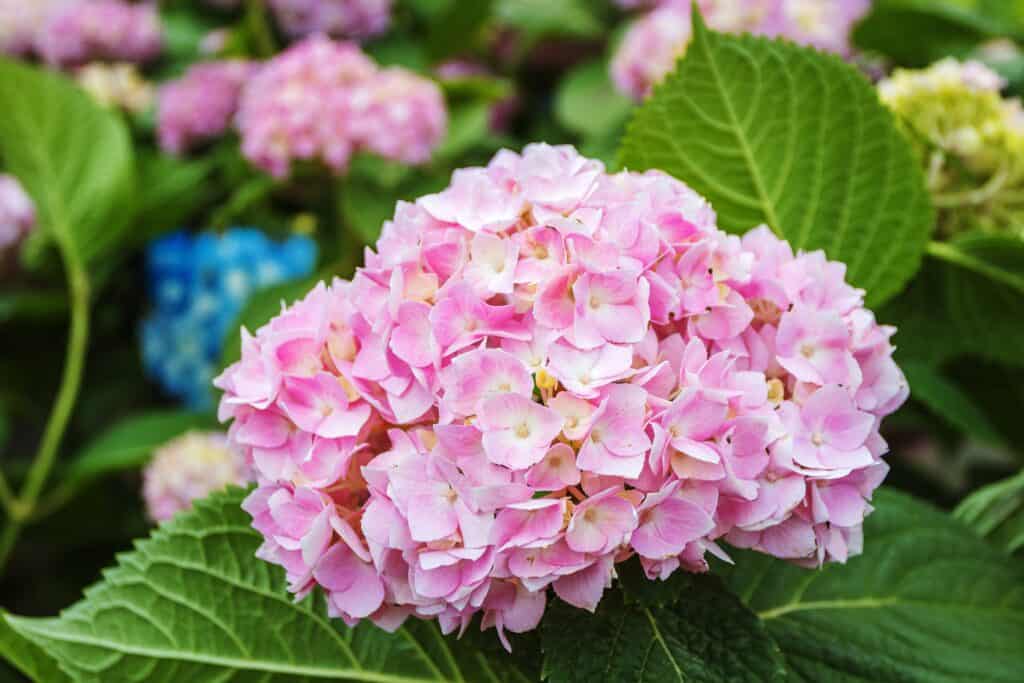
Hydrangeas thrive with morning sun and afternoon shade.
©Lux pictura/Shutterstock.com
Perennial type: Shrub
Hardiness zones: 3-7
Sunlight needs: Full sun to part shade
Hydrangeas are beautiful flowering shrubs that come in many varieties and colors. The hydrangea blooms can range from pure white to deep pink and purple, depending on the variety and soil pH. The flowers form magnificent clusters, and they can last from early summer all the way to fall. Plus, they have large rounded leaves that provide a vivid contrast to their showy blooms.
Hydrangeas thrive with morning sun and afternoon shade. And hydrangeas are not prone to pests and diseases. However, watch for powdery mildew on hydrangea leaves after days of high humidity.
When pruning your hydrangea, there’s no need to be aggressive. Instead, trim the stems by one-third of their length, cutting right above a bud. Also, prune hydrangeas in late winter or early spring while they’re still dormant.
There are many types of hydrangea plants to choose from, including the following brief list:
- Climbing Hydrangea
- French Hydrangea
- Oakleaf Hydrangea
- Panicled Hydrangea
- Smooth Hydrangea.
10. Lavender
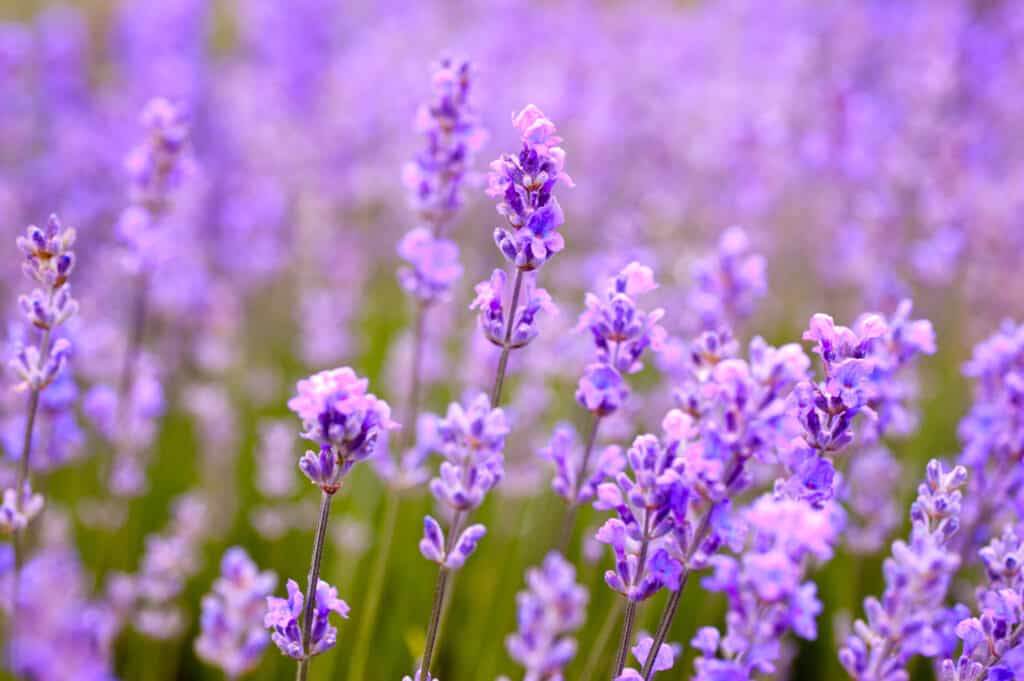
English lavender
does best in fully sunny spots. It is drought-tolerant and low maintenance.
©reya-photographer/Shutterstock.com
Perennial type: Herbaceous
Hardiness zones: 5-9
Sunlight needs: Full sun
Lavender is one of the best perennial plants that come back every year because it smells so good and is easy to grow. English lavender (Lavandula angustifolia) is ideal for gardens due to its long-lasting blooms. The stems are sturdy, growing to heights of up to 3 feet, with tiny purple flowers growing on stalks. In addition, sweet-smelling lavender plants attract pollinators like bees and butterflies.
English lavender does best in fully sunny spots; it is drought-tolerant and doesn’t require much maintenance. For the most part, this plant can tolerate cold temperatures. Still, it may need a covering of straw or burlap in the winter if temperatures drop below 20°F.
Deadheading summer blooms will extend the flowering period of your lavender plants. Also, prune your lavender each spring to keep the plants looking tidy and encourage new growth.
11. Peony

Peonies are slow-growing plants, so there’s no need to prune them too much.
©360VP/Shutterstock.com
Perennial type: Herbaceous
Hardiness zones: 3-8
Sunlight needs: Full sun to partial sun
Peonies are prized for their showy flowers and fragrance. These stunning plants have been grown for centuries, with some varieties dating back to the 1500s or earlier. Their fluffy round blooms come in many colors, from pink to white to deep red. Plus, peonies are long-lived, with some plants lasting up to 100 years!
The peony’s bushy foliage is a deep green, providing a beautiful backdrop to those vibrant flowers. Peonies prefer sunny spots, but they can also tolerate a bit of shade. In addition, these perennial plants require well-draining soil and regular watering.
Peonies are slow-growing plants, so there’s no need to prune them too much. But if you want to encourage bushiness and reduce their size, you can trim off spent flowers and dead foliage. Then, get the most out of your peonies by dividing them every four to five years.
12. Rhododendron
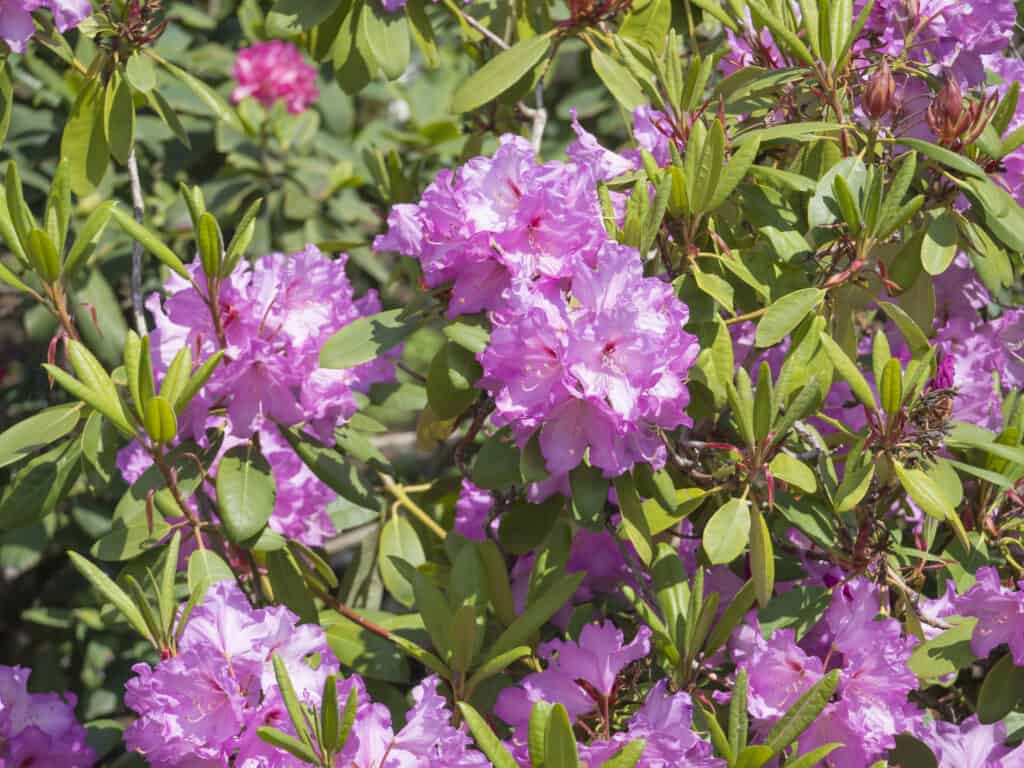
Rhododendrons are well suited to moderately shady spots.
©iStock.com/Kristyna Sindelkova
Perennial type: Shrub
Hardiness zones: 5-8
Sunlight needs: Partial sun to moderate shade
Rhododendrons are showy evergreen shrubs with glossy leaves and beautiful clusters of bell-shaped flowers. The blooms can be pink, red, white, and more colors depending on the variety. Plus, these beauties offer year-round interest, with many types boasting colorful foliage and decorative berries in the fall and winter months.
Rhododendrons are well suited to moderately shady spots. Still, they can tolerate some sun as long as they get enough water. Moreover, successfully growing rhododendrons requires planting them in acidic soil. So test your soil first for the ideal pH of 4.5-6.0.
No pruning is necessary for most rhododendrons, but you can trim off any dead branches or flowers after the blooming season has ended.
13. Salvia

Salvia does best in full sun, but some varieties thrive in partial shade.
©liewluck/Shutterstock.com
Perennial type: Herbaceous
Hardiness zones: 4-10
Sunlight needs: Full sun to partial shade
Similar to the look of lavender plants, salvias are perfect for garden beds, window boxes, and other containers. These flowering perennial plants offer beautiful, richly colored blooms in shades of pink, purple, and more. Also, like lavender, salvia plants smell lovely! In addition, salvia’s wonderfully scented flowers attract bees and butterflies.
Salvia does best in full sun, but some varieties thrive in partial shade. These pretty plants need well-draining soil and regular watering for optimal growth. Although salvia is reasonably drought-tolerant once established.
Take note that salvia can grow 3-5 feet tall, which often causes its flower stalks to tip over and fall to the ground. So, a bit of pruning is beneficial for most salvia varieties.
Pruning salvia in late winter or early spring can help keep your plants looking tidy and promote healthy new growth. And you’ll definitely want to deadhead the dead summer blooms to encourage another flowering.
14. Shrub Rose
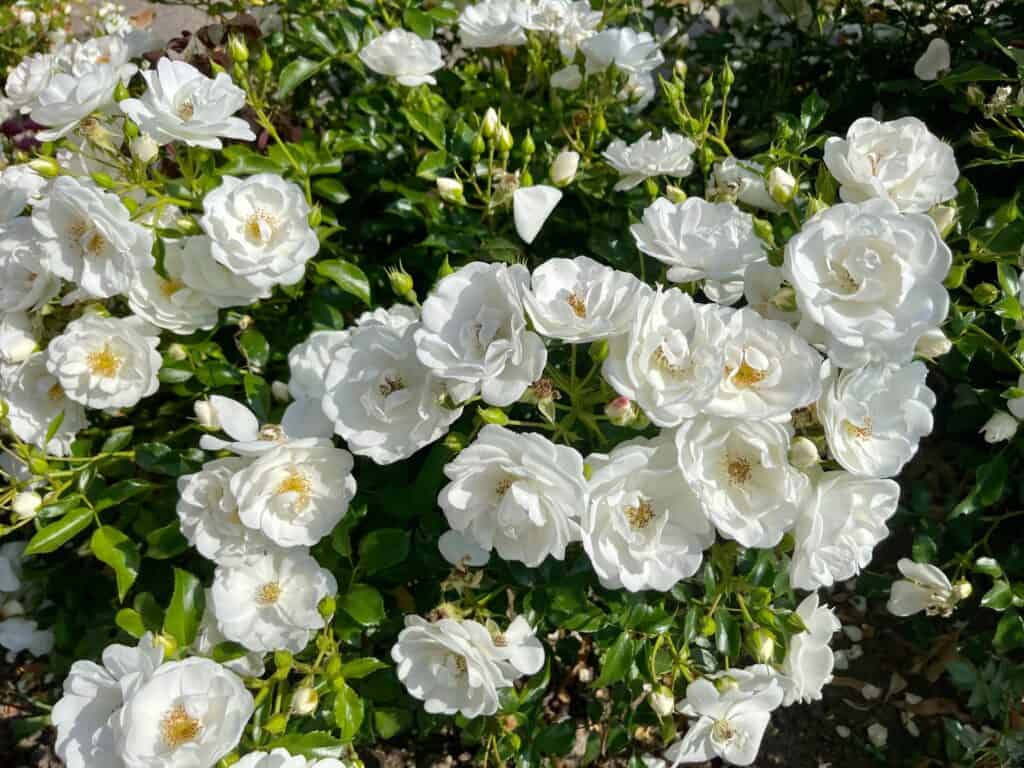
Shrub roses thrive in direct sunlight and moist but well-draining soil.
©Olga Ganovicheva/Shutterstock.com
Perennial type: Shrub
Hardiness zones: 4-9
Sunlight needs: Full sun
If you’ve been bypassing roses because you think they’re harder to grow than other perennial plants, give the shrub rose a try! Shrub roses are ideal for people who want a rose’s beauty without much maintenance. This type of rose is often bushier than other varieties and can spread 6-10 feet. So give it lots of space and plan to prune it once a year.
Shrub roses thrive in direct sunlight and moist but well-draining soil. As with other roses, it’s important to provide your shrub rose with plenty of fertilizer and soil amendments. Additionally, pruning in early spring (before new growth begins) is necessary to ensure your roses stay healthy and continue producing blooms.
The Best Perennial Plants Are Hardy and Beautiful!
Perennials are the backbone of any garden and provide beautiful blooms for many years to come. Whether as bold flowers like peonies or delicate blooms like columbine, perennials offer endless possibilities to jazz up your outdoor space. With proper care and maintenance, these hardy perennial plants will reward you with beautiful blooms year after year.
Summary of the 14 Best Perennial Plants That Come Back Every Year
Here’s a recap of 14 fantastic perennial plants that we took a look at.
| Rank | Plant | Perennial Type | Hardiness Zones |
|---|---|---|---|
| 1 | Bearded Iris | Bulb | 3-10 |
| 2 | Black-Eyed Susan | Herbaceous | 3-9 |
| 3 | Clematis | Herbaceous vine | 4-8 |
| 4 | Columbine | Herbaceous | 3-8 |
| 5 | Daylily | Herbaceous | 3-9 |
| 6 | Fountain Grass | Grass | 5-10 |
| 7 | Geranium | Herbaceous | 4-9 |
| 8 | Hosta | Herbaceous | 3-9 |
| 9 | Hydrangea | Shrub | 3-7 |
| 10 | Lavender | Herbaceous | 5-9 |
| 11 | Peony | Herbaceous | 3-8 |
| 12 | Rhododendron | Shrub | 5-8 |
| 13 | Salvia | Herbaceous | 4-10 |
| 14 | Shrub Rose | Shrub | 4-9 |
The photo featured at the top of this post is © qiufan bu/Shutterstock.com
Sources
- The Royal Horticultural Society, Available here: https://www.rhs.org.uk/plants/rhododendron/on-alkaline-soil
- Native Plant Trust, Available here: https://gobotany.nativeplanttrust.org/species/rudbeckia/hirta/#:~:text=Facts,cultivated%20strains%20may%20be%20introduced.
- Regents of the University of Minnesota, Available here: https://extension.umn.edu/yard-and-garden-news/when-prune-hydrangeas-best-bloom#:~:text=Prune%20back%20stems%20to%20just,until%20late%20winter%20or%20spring
Thank you for reading! Have some feedback for us? Contact the AZ Animals editorial team.






